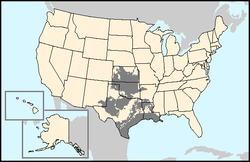- Mid-Continent oil province
-
The Mid-continent oil field is a broad area containing hundreds of oil fields in Arkansas, Kansas, Louisiana, New Mexico, Oklahoma and Texas. The area, which consists of various geological strata and diverse trap types, was discovered and exploited during the first half of the 20th century. Most of the crude oil found in the onshore mid-continent oil field is considered to be of the mixed base or intermediate type (a mix of paraffin base and asphalt base crude oil types).
Contents
History
The first commercially successful oil well drilled in what was to be called the Mid-continent Oil Field was the Norman No. 1 near Neodesha, Kansas, on November 28, 1892. The successes that followed of the Nellie Johnstone No. 1 (Bartlesville, Oklahoma) in 1897, Spindletop (Texas) in 1901, and the Ida Glenn No. 1 (Glenn Pool, Oklahoma) in 1905, demonstrated the existence of a large oil field in the central and southwestern United States. It became known as the Mid-continent Oil Field. Continued drilling found many other oil fields and pools within the Mid-continent, both large and small.
Historically this area has produced more oil than any other area in the United States, and until the discovery of oil in the Middle East, was the largest known oil reserve in the world. The Texas Railroad Commission estimates that the Texas reserves alone were 190 billion barrels (3.0×1010 m3) of oil including the little more than 60 billion (10 km³) already produced.
Laws in the early days gave the oil flowing from the well-head to the owners of the well, prompting nearby property owners and lease holders to drill as many wells as possible to ensure they received the profits for the oil under their land. This led to rapid depletion of the resources and the immediate fall of oil prices. Also, the resulting influx of thousands of oil field workers led to wild growth of nearby boom towns and the lawlessness that accompanied them. The states eventually succeeded in regulating the industry and passing laws for the equitable distribution of oil royalties.
Because of this early uncontrolled exploitation, much of the reserves in the Mid-continent have been depleted. Oil operators, in addition to continued exploration, use a variety of techniques to increase production, including deep wells, injection wells, etc. Natural gas, which in the early days was vented to the atmosphere or burned off, now accounts for a large percentage of the exploration efforts and profitability of the petroleum industry in the Mid-continent.
Proven oil reserves
- Arkansas: 37 million barrels (5,900,000 m3)—Ranked 19th in the U.S.
- Louisiana: 428 million barrels (68,000,000 m3)—Ranked 7th in the U.S.
- Kansas: 263 million barrels (41,800,000 m3)—Ranked 12th in the U.S.
- New Mexico: 705 million barrels (112,100,000 m3)—Ranked 5th in the U.S.
- Oklahoma: 569 million barrels (90,500,000 m3)—Ranked 6th in the U.S.
- Texas: 4,871 million barrels (774,400,000 m3)—Ranked 1st in the U.S.
Historic oil fields within the Mid-continent Oil Field
- Corsicana, 1896, Texas, plus 44 million barrels (7,000,000 m3) little reserve remaining
- Bartlesville, 1897, Nellie Johnstone No. 1, Oklahoma, plus 1.6 billion barrels (250,000,000 m3) in decline
- Burbank (Osage), 1897, Oklahoma, plus 1 billion barrels (160,000,000 m3) still active
- Spindletop, 1901, Texas, plus 150 million barrels (24,000,000 m3) little reserve remaining
- Glenn Pool, 1905, Ida Glenn No. 1, Oklahoma, 325 million barrels (51,700,000 m3) little reserve remaining
- Cushing, 1912, Oklahoma
- Healdton, 1913, Franklin No. 1, Oklahoma
- Greater Seminole, 1926, Oklahoma, plus 200 million barrels (32,000,000 m3)
- McCamey, 1928, Baker No. 1., Texas
- Oklahoma City, No. 1 Discovery Well, 1928, Oklahoma. The Mary Sudik No. 1, "Wild Mary Sudik", gusher did not blow until March 25, 1930—she sprayed an estimated 3,000 barrels (480 m3) an hour (133 L/s) for the next 11 days
- East Texas, 1930, Bradford No. 3, Texas
- Caddo Pine Island, Louisiana, Auffenhauser No. 1, 1906
- Smackover, Arkansas, No. 1 J.T. Murphy, 1922
- El Dorado, Arkansas, Hill No. 1, 1919
- Rodessa, Caddo Parish, Louisiana, O.J. Hill No. 1, 1929
- Homer, Claiborne Parish, Louisiana, Shaw, 1919
- Haynesville, Claiborne Parish, Louisiana, Taylor No. 2, 1921
- Bull Bayou, Red River Parish, Louisiana, 1913
- Monroe Gas Field, Ouachita Parish, Louisiana, 1916
External links
- Energy Information Administration (DOE)[dead link]
- U.S. Energy Information Administration (DOE), "Crude Oil Proved Reserves, Reserves Changes, and Production"
Categories:- Oil fields of the United States
- History of oil in Oklahoma
- Energy resource facilities in Kansas
- Energy resource facilities in Louisiana
- Energy resource facilities in Arkansas
- Energy resource facilities in New Mexico
- Energy resource facilities in Oklahoma
- Energy resource facilities in Texas
Wikimedia Foundation. 2010.

